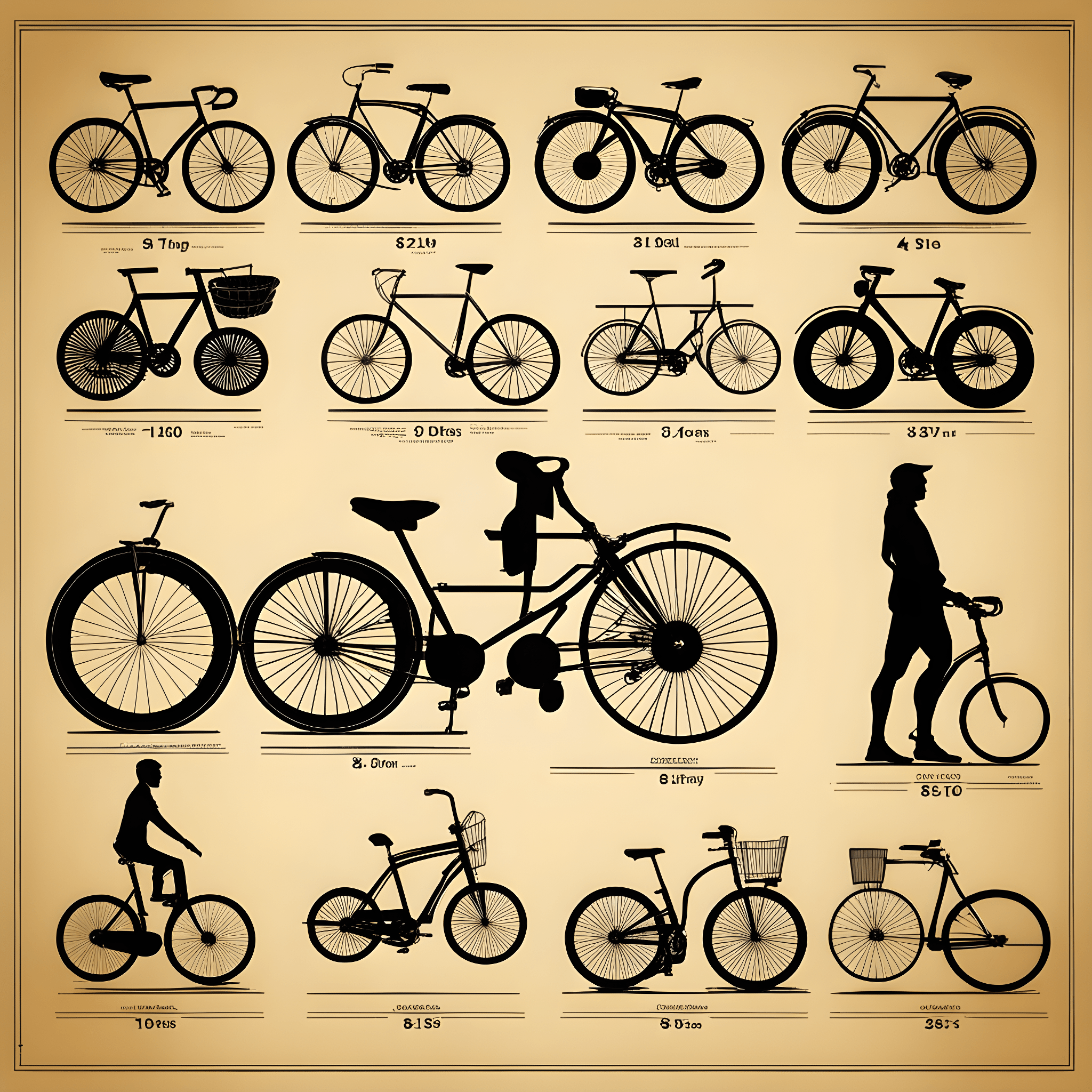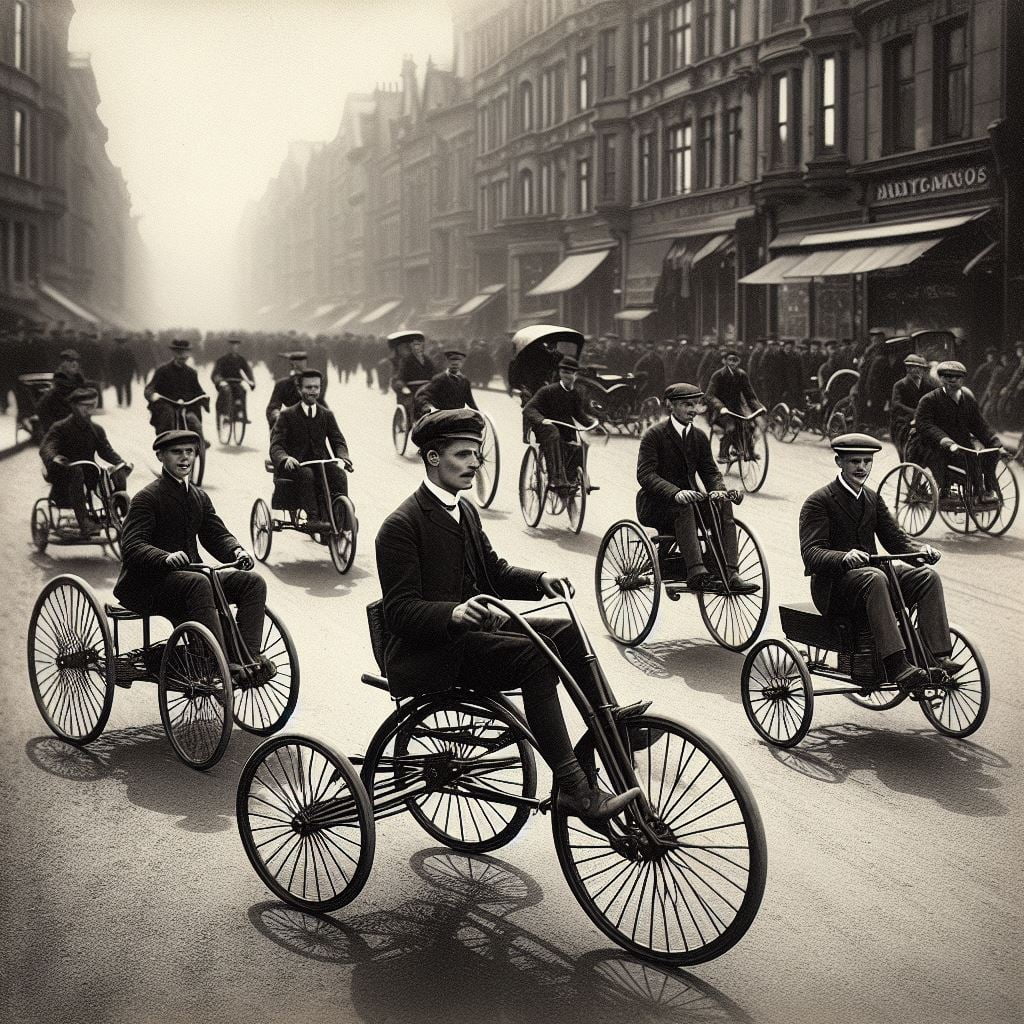

Introduction: Invention of Bicycle
The bicycle, a symbol of freedom and human ingenuity, boasts a fascinating history filled with surprising inventions and quirky designs. But before sleek road bikes and mountain trails, the journey began with a much simpler contraption. Did you know the first bicycles actually required you to push yourself along with your feet, like a modern-day scooter?
This remarkable invention of bicycle, and the incredible evolution that followed, not only revolutionized transportation but also empowered individuals, shaped social movements, and continues to be a symbol of a healthier, more sustainable future. Let’s hop on a metaphorical time machine and explore the captivating story of the bicycle, from its humble beginnings to the two-wheeled wonder we know today!
Timeline of Bicycle Development
The bicycle’s journey from a rudimentary wooden contraption to the sleek, high-tech machines of today is a fascinating tale of innovation and human ingenuity. Here’s a timeline highlighting the key milestones in the evolution of the bicycle:
1817-1819: The Draisine or Velocipede (The Dawn of Two Wheels):
Before sleek road bikes and adrenaline-pumping mountain trails, the story of the bicycle begins with a seemingly rudimentary contraption – the Draisine. Invented by the ingenious German inventor Karl Drais von Sauerbronn (1785-1851) between 1817 and 1819, the Draisine (also known as a dandy horse or hobby horse) marked a pivotal moment in transportation history. While it may not resemble the bicycles we know today, it laid the foundation for the two-wheeled revolution that would follow.
Karl Drais: A Visionary Mind:
Drais wasn’t solely focused on transportation. He was a multifaceted individual with a keen interest in forestry and natural sciences. His invention of the Draisine stemmed from his desire for a faster and more efficient way to travel forest paths for his forestry work.
The Design and Functionality of the Draisine:
The Draisine was a minimalist marvel. Imagine a wooden frame with two wheels, a cushioned saddle, and a pivotal front wheel for steering. Unlike modern bicycles, it lacked pedals, brakes, and the familiar handlebar design. Riders propelled themselves forward by pushing their feet on the ground, similar to a modern-day scooter. This innovative design, although basic, offered several advantages over walking:
- Increased Speed: Compared to walking, the Draisine allowed for faster travel, particularly on smooth surfaces.
- Improved Comfort: The cushioned saddle provided a more comfortable riding experience compared to walking long distances.
- Novelty and Recreation: The Draisine quickly became a popular novelty item, particularly among the upper classes in Europe. It offered a new form of leisure activity and a chance to experience a sense of freedom and speed.

Limitations and Nicknames:
Despite its advantages, the Draisine had its limitations. The lack of pedals meant riders became tired quickly, especially on uphill journeys. The steering also required practice, and the absence of brakes made controlling speed downhill a challenge. These limitations earned the Draisine nicknames like the “hobby horse” or the “dandy horse,” highlighting its recreational nature and somewhat precarious design.
A Spark of Innovation:
Although not a perfect machine, the Draisene’s impact was undeniable. It captured the public’s imagination and sparked a wave of innovation in personal transportation. The limitations of the Draisine would inspire inventors to address its shortcomings, paving the way for the development of bicycles with pedals, brakes, and more sophisticated steering mechanisms.
Historical Context:
The invention of the Draisine coincided with a period of significant change in Europe. The Industrial Revolution was gaining momentum, leading to advancements in metalworking and manufacturing. This provided the fertile ground for further development of the Draisine concept, allowing inventors to explore new materials and designs for bicycles.
Further Exploration:
If you’d like to delve deeper into the world of Karl Drais and his invention, here are some resources:
1820s to 1850s: An Era of 3 and 4-Wheelers:
The story of the bicycle’s invention isn’t a straight shot from Karl Drais’s wooden “Laufmaschine” (running machine) to the sleek two-wheeled machines of today. In the decades between the Draisine’s introduction in 1817 and the widespread adoption of pedal bicycles in the late 19th century, inventors tinkered with various designs, including some rather curious three and four-wheeled contraptions.
Why Three and Four Wheels?
While the Draisine offered a novel mode of transportation, its limitations were apparent. Stability, particularly at higher speeds, was a concern. Additionally, the act of propelling oneself with one’s feet could be tiring, especially for long distances. These issues prompted inventors to explore alternative designs, hoping to address these drawbacks.
The Rise of the Tricycles and Quadracycles:
The 1820s and 1830s saw a surge in experimentation with three and four-wheeled human-powered vehicles. These “tricycles” and “quadracycles” came in a variety of configurations, utilizing treadles, cranks, and even hand cranks for propulsion. Some notable examples include:
- Macmillan’s “Hobby-Horse” (1839): Scottish blacksmith Kirkpatrick Macmillan is credited with creating a wooden tricycle with a treadle mechanism for propulsion. However, there’s limited evidence to definitively prove his invention.
- Gauthier’s Tricycle (1840s): French inventor Louis-Joseph Gauthier’s tricycle featured a more elaborate design with spoked wheels and a steering mechanism. It was propelled by treadles connected to the rear axle. (Quadracycle)
- Manning’s “Velocipede” (1843): American inventor John Augustus Manning’s four-wheeled “Velocipede” (not to be confused with the later Michaux’s Velocipede) utilized a hand-crank mechanism to drive the front wheels.
The Challenges of Three and Four Wheels:
Despite the ingenuity behind these designs, several factors hampered their widespread popularity:
- Increased Complexity: These vehicles were often more complex to build and maintain compared to the simpler Draisine.
- Weight and Bulk: Three and four wheels added significant weight, making them cumbersome and less maneuverable.
- Limited Efficiency: The various propulsion mechanisms weren’t always as efficient as the simple foot-powered method of the Draisine.

A Stepping Stone, Not a Dead End:
While three and four-wheeled bicycles never became mainstream, their role in the bicycle’s evolution shouldn’t be dismissed. They served as a testing ground for different propulsion mechanisms and steering systems. The experimentation during this period contributed to the development of key concepts like the crank and drivetrain, which would be crucial for the success of later pedal bicycles.
Beyond the Blog: Exploring Further
If you’re curious to delve deeper into the world of three and four-wheeled bicycles, here are some resources:
- The Richard Henry Pease Collection at the National Museum of American History: This online collection contains images and information about various early bicycles, including some tricycles and quadracycles.
- The Michaux Velocipede on Wikipedia: While not a three or four-wheeled design, this article provides context for the “Velocipede” name used by some early inventors.
- The Dandy Horse website: This website explores the history of the early bicycle, including the Draisine and some lesser-known tricycles.
1830s: The Reported Scottish Inventions (Unverified Claims):
The story of the bicycle’s invention is a winding path paved with ingenuity and experimentation. While Karl Drais’s Draisine in 1817 is widely recognized as the first commercially successful two-wheeled vehicle, whispers of earlier innovations linger in the historical record. Enter the intriguing case of the Scottish “unicycles” of the 1830s, shrouded in mystery and lacking definitive proof.
Kirkpatrick Macmillan and Gavin Watson: These two Scottish inventors are the names that surface in connection with these unconfirmed pedal-powered bicycles. While details are scarce, some accounts suggest that Macmillan, a blacksmith from Dumfries and Galloway, created a wooden “two-wheeled carriage” with pedals around 1830. Similarly, stories circulate about Gavin Watson, a coachbuilder from Glasgow, inventing a pedal-driven device during this period.
Lack of Evidence, Enduring Enigma:
Unfortunately, the absence of concrete evidence – patents, drawings, or physical remnants – prevents these claims from being definitively verified. Unlike Drais’s well-documented Draisine, there’s no substantial proof to solidify the existence of these early Scottish bicycles.
Why Does This Matter?
Despite the lack of confirmation, the possibility of these Scottish inventions adds another layer of intrigue to the bicycle’s origin story. It suggests that the concept of a pedal-powered two-wheeler might have been bubbling under the surface in various parts of Europe during the early 19th century, not just in Germany with Drais.
Digging Deeper: The Search for the Missing Pieces
Several factors contribute to the obscurity of these potential inventions:
- Limited Documentation: Inventions during this period, especially by non-established individuals, might not have been formally documented or patented. Newspapers or local records from the time period could potentially hold clues if they mentioned these “unicycles.”
- Focus on Drais: Drais’s Draisine captured the public imagination and dominated early discussions about two-wheeled locomotion. This could have overshadowed any potential Scottish inventions.
- Loss of Prototypes: Early prototypes were often made of wood and other less durable materials. The passage of time and lack of recognition could have resulted in these early bicycles being lost or destroyed.
Further exploration:
- The Bicycle History Museum: This museum offers a comprehensive archive of bicycle history, and you might find related articles or discussions on their website.
- The National Cycle Archive (UK): This archive might hold historical documents or newspaper clippings mentioning early Scottish bicycles.
- Journal Articles: Scholarly journals on the history of technology or transportation might have explored these unconfirmed inventions. Searching academic databases for articles with keywords like “early bicycles,” “Scottish inventions,” or “unicycle” could be fruitful.
1853: The Birth of the Pedal Bicycle (Tretkurbelfahrrad):
The story of the bicycle is often dominated by the iconic Penny-Farthing or the revolutionary Safety Bicycle. However, long before these recognizable designs, a lesser-known inventor laid the groundwork for the modern bicycle: Philipp Moritz Fischer.
Fischer, a German blacksmith from Mannheim, is credited with creating the first practical pedal bicycle in 1853, aptly named the Tretkurbelfahrrad (tretkurbel – crank, fahrrad – bicycle). This invention, though often overshadowed, marked a pivotal moment in bicycle history.
A Blacksmith with a Vision:
Unfortunately, detailed information about Philipp Moritz Fischer’s life remains scarce. Historical records suggest he was born around 1780 and resided in Mannheim, a city in southwestern Germany with a rich history of innovation.
While the exact circumstances surrounding his invention are unclear, it’s likely that Fischer, like many inventors of the time, was inspired by the earlier “running machines” like Karl Drais’s Draisine (1817). These early contraptions sparked a fascination with human-powered transportation, but their lack of pedals limited their practicality.

The Tretkurbelfahrrad: A Simpler, More Efficient Ride
Fischer’s genius lay in his simplicity. The Tretkurbelfahrrad featured a wooden frame, similar to the Draisine, but crucially, it incorporated a crank mechanism that connected the pedals directly to the rear wheel. This seemingly minor addition revolutionized the riding experience. Riders could now propel themselves forward by rotating the pedals in a circular motion, eliminating the need to push themselves off the ground with their feet.
This innovation offered several advantages:
- Increased Efficiency: Pedaling provided a more efficient and less tiring way to propel the bicycle.
- Greater Speed: The crank mechanism allowed for faster and more sustained movement compared to pushing with the feet.
- Improved Comfort: Riders could sit comfortably on the saddle while pedaling, offering a more enjoyable riding experience.
A Stepping Stone to the Future:
Despite its advantages, the Tretkurbelfahrrad wasn’t without limitations. The wooden frame was heavy, the crank mechanism was likely basic, and the overall design lacked the refinement of later bicycles.
However, Fischer’s creation served as a crucial stepping stone. News of the Tretkurbelfahrrad spread through Germany and beyond, inspiring other inventors like the Frenchmen Pierre and Ernest Michaux who, a decade later, developed the more well-known “Velocipede” with its iconic large front wheel.
A Legacy of Innovation:
While Philipp Moritz Fischer may not be a household name, his contribution to the bicycle’s evolution is undeniable. The Tretkurbelfahrrad demonstrated the potential of pedal-powered transportation, paving the way for generations of inventors to refine and improve upon the design.
Further Exploration:
If you’re interested in learning more about the history of the bicycle and other unsung inventors, here are some resources:
- Bicycle History Museum
- Sheldon Brown’s Bicycle Glossary: (See entry on “History of Bicycles”)
1860s and the Michaux “Velocipede” (The “Boneshaker”):
Prior to the sleek, gear-shifting machines we know today, the bicycle’s evolution took a significant leap forward in the 1860s with the introduction of the Michaux “Velocipede.” This invention, by French entrepreneur Pierre Michaux (a blacksmith) and his son Ernest Michaux, popularized the concept of the bicycle and paved the way for future advancements.
From Blacksmith to Bicycle Pioneer: The Story of Pierre Michaux
Pierre Michaux wasn’t always a bicycle innovator. He began his career as a blacksmith in Paris, supplying parts for the carriage trade. However, the early 1860s saw a growing interest in velocipedes, rudimentary two-wheeled vehicles propelled by the rider’s feet. Seeing an opportunity, Michaux, along with his son Ernest, started experimenting with these early bicycle designs.
The Michaux “Velocipede” – A Design with Quirks
The Michaux “Velocipede” differed significantly from earlier inventions like the Draisine (powered by the rider pushing off the ground) and featured several key characteristics:
- Large Front Wheel, Small Rear Wheel: This iconic design, nicknamed the “penny-farthing” decades later, became synonymous with early bicycles. The large front wheel allowed riders to cover greater distances with each pedal rotation, increasing speed compared to previous models.
- Pedal Power: A major innovation of the Michaux “Velocipede” was the addition of pedals directly attached to the axle of the large front wheel. This allowed riders to propel themselves forward more efficiently and comfortably compared to foot-powered designs.
- Iron Frame: While innovative, the “Velocipede” still relied on a heavy iron frame for construction. This, combined with the lack of suspension, resulted in a notoriously rough ride, earning it the nickname “boneshaker.”
A Bumpy Ride to Popularity
Despite its limitations, the Michaux “Velocipede” achieved several things:
- Increased Popularity: The “Velocipede” became a popular novelty in France and other parts of Europe. People flocked to try this new mode of transportation, and the Michaux company saw significant commercial success.
- Inspired Further Innovation: The limitations of the “Velocipede,” particularly the rough ride and safety concerns due to the high center of gravity, spurred further advancements in bicycle design. Inventors like James Starley would later introduce features like pneumatic tires and the “safety bicycle” with two wheels of similar size, offering a more comfortable and stable riding experience.
Historical Context:
The 1860s marked a period of significant technological advancements. The American Civil War (1861-1865) saw the early use of telegraphs and photography for wartime communication and documentation. Inventions like the Bessemer process (revolutionizing steel production) were also developed around this time. The Michaux “Velocipede” emerged within this context of innovation, reflecting the era’s spirit of invention and progress.
Further Exploration:
- National Museum of American History (Smithsonian Institution): This website offers a comprehensive look at the bicycle’s evolution, including an interactive timeline featuring the Michaux Velocipede.
- The Richard Faulds Collection (University of Glasgow): This online resource from the University of Glasgow delves deep into the history of cycling, with detailed information on early bicycles like the Velocipede.
1870s: The High-Wheeler Era (Penny Farthing):
The 1870s marked a fascinating chapter in bicycle evolution with the rise of the Penny-Farthing, a design that captured the public’s imagination with its grandeur and speed but also presented some unique challenges.
Origin of the Name:
The “Penny-Farthing” nickname playfully compares the bicycle’s wheels to British coins – the large front wheel resembling a penny and the smaller rear wheel a farthing (a quarter of a penny). This comparison highlights the defining characteristic of this era’s bicycles: a dramatically larger front wheel compared to the rear.

Innovation and Speed:
The Penny-Farthing emerged from advancements made with the Michaux Velocipede. Inventors like James Starley addressed the limitations of the “boneshaker” by:
- Enlarging the Front Wheel: The most striking feature, the massive front wheel, allowed riders to cover greater distances with each pedal rotation. This innovation significantly increased speed compared to previous bicycle designs. Sources claim some Penny-Farthings could reach speeds of up to 25 mph (40 km/h), a remarkable feat for the time.
- Spoked Wheels: Solid iron wheels were replaced with lighter spoked wheels, improving maneuverability and reducing weight.
- Improved Gearing: Early versions lacked gear systems, but rudimentary gearing mechanisms were introduced during the Penny-Farthing era, allowing riders to adjust their pedaling for different terrains.
A Glimpse into the Historical Context:
The 1870s witnessed significant developments across various sectors. The American Reconstruction era (1865-1877) was a period of rebuilding after the Civil War. The invention of the telephone by Alexander Graham Bell in 1876 revolutionized communication. The Penny-Farthing’s rise coincided with this spirit of innovation and progress, reflecting a desire for faster and more efficient transportation.
The Penny-Farthing’s Challenges:
While innovative for its time, the Penny-Farthing had limitations:
- Dangerous Design: The high center of gravity due to the large front wheel made mounting and dismounting a precarious task. Falls from a height could result in serious injuries, leading to Penny-Farthing’s reputation as a somewhat dangerous design.
- Limited Comfort: The small rear wheel and lack of suspension resulted in a bumpy ride, especially on uneven terrain.
A Stepping Stone to the Future:
Despite its limitations, the Penny-Farthing played a crucial role in bicycle history:
- Popularized Cycling: The Penny-Farthing’s unique design and faster speeds attracted a wider audience to cycling, leading to the formation of cycling clubs and increased recreational use of bicycles.
- Paved the Way for Future Advancements: The shortcomings of the Penny-Farthing, particularly the safety concerns, spurred further innovation. This eventually led to the development of the “safety bicycle” in the late 19th century, featuring two wheels of similar size and a more stable design.
Further Reading:
- National Museum of American History (Smithsonian Institution): This website offers an interactive timeline featuring the Penny-Farthing, showcasing its design and historical context.
- Penny-Farthing History (Sheldon Brown’s Bicycle Glossary): This website by renowned bicycle expert Sheldon Brown provides a technical breakdown of the Penny-Farthing design, its strengths, and weaknesses.
The Safety Bicycle and the Bike Boom (1880s and 1890s):
The iconic “Penny Farthing” with its massive front wheel may be synonymous with early bicycles, but it wasn’t exactly known for stability or safety. Concerns about rider safety, particularly the precarious dismounts and potential for falls from a great height, fueled a new wave of innovation in the late 19th century. Enter the “safety bicycle,” a revolutionary design that ushered in a golden age of cycling, the “bicycle boom.”
A Pioneering Visionary: John Kemp Starley
At the forefront of this bicycle revolution stood English inventor John Kemp Starley. Born in 1854, Starley wasn’t just an inventor; he was a visionary who recognized the limitations of the Penny Farthing and the potential for a safer, more practical bicycle. In 1877, Starley’s company, the Rover Cycle Company, introduced the “Safety Bicycle.” This groundbreaking design featured several key innovations:
- Two Wheels of Similar Size: Replacing the giant front wheel of the Penny Farthing, the “Safety Bicycle” boasted two wheels of similar size. This lowered the center of gravity, making the bicycle significantly more stable and reducing the risk of tipping over.
- Chain-Driven Rear Wheel: The “Safety Bicycle” introduced a chain-driven rear wheel mechanism. This offered a more efficient and smoother ride compared to the direct-drive system on the Penny Farthing’s front wheel.
- Diamond Frame: The “Safety Bicycle” also introduced the now-iconic diamond frame design. This lightweight and sturdy frame provided a strong foundation for the bicycle’s components, further enhancing stability and handling.

The Perfect Match: Pneumatic Tires and the “Safety Bicycle”
The success of the “Safety Bicycle” was further amplified by another crucial invention: the pneumatic tire. Patented in 1888 by Scottish veterinarian John Boyd Dunlop, these air-filled tires revolutionized cycling comfort. They significantly reduced the harsh bumps and vibrations experienced on solid rubber tires, making cycling a much more enjoyable experience for riders of all ages and abilities.
The “Bicycle Boom” Takes Hold!
The combination of the “Safety Bicycle” and pneumatic tires sparked a global phenomenon known as the “bicycle boom” in the 1880s and 1890s. Here’s what fueled this surge in popularity:
- Increased Safety and Accessibility: The “Safety Bicycle” attracted a wider audience compared to the intimidating Penny Farthing. It was easier to mount, dismount, and maneuver, making cycling accessible to women, children, and even older adults.
- Improved Comfort: Pneumatic tires added a layer of comfort previously unimaginable, further encouraging people to explore cycling for recreation and transportation.
- A Symbol of Freedom and Progress: The bicycle became a symbol of freedom and progress, particularly for women. It offered them a new level of independence and mobility, challenging societal norms at the time.
- Social Impact: Cycling clubs and cycling events flourished during the “bicycle boom,” fostering a sense of community and camaraderie among riders.
Historical Context:
The “bicycle boom” coincided with several historical developments that likely contributed to its success:
- Urbanization: The late 19th century saw rapid urbanization in Europe and North America. The “Safety Bicycle” offered a convenient and affordable mode of transportation for navigating increasingly crowded cities.
- Technological Advancements: The industrial revolution spurred advancements in metalworking and manufacturing, enabling mass production of affordable bicycles.
- The Rise of Leisure Time: As working hours began to decrease, people had more time for leisure activities. Cycling emerged as a popular recreational pursuit, enjoyed by individuals and families alike.
Further Reading:
- National Geographic: The Bicycle Boom of the 1890s: This National Geographic article explores the cultural phenomenon of the bicycle boom and its lasting influence.
20th Century and Beyond: Refining and Diversifying the Bicycle:
The 20th century witnessed the bicycle blossom from a revolutionary invention into a ubiquitous machine. But the story doesn’t end there. Advancements in materials, technology, and design philosophy continued to propel the bicycle forward, creating a diverse and ever-evolving landscape of two-wheeled wonder.
A Material Revolution:
- Lighter and Stronger Frames: The early 20th century saw a shift from heavy steel frames to lighter and stronger materials like aluminum and later, titanium and carbon fiber. This resulted in lighter, more responsive bicycles, enhancing performance and comfort.
- Improved Gearing Systems: The introduction of derailleurs in the 1930s allowed riders to change gears with ease, tackling hills and varying terrains more efficiently. Today, electronic gear shifting offers seamless and precise gear changes.
- Advanced Brakes: Rim brakes gave way to disc brakes in the latter half of the 20th century, providing superior stopping power in all weather conditions.
Specialization Takes Hold:
The 20th century witnessed the rise of specialized bicycle types, catering to specific needs and riding styles:
- Road Bikes: These lightweight machines prioritize speed and efficiency, featuring aerodynamic designs, drop handlebars, and multiple gear configurations for conquering long distances and competitive races.
- Mountain Bikes (MTBs): Emerging in the 1970s, mountain bikes revolutionized off-road cycling. These rugged machines boast sturdy frames, wide knobby tires for superior traction, and suspension systems for absorbing bumps and jumps on rough terrain.
- Commuter Bikes: Designed for practicality and reliability, commuter bikes often come equipped with fenders, lights, and racks for carrying bags, making them ideal for everyday urban errands.

Beyond the 20th Century: A Look at the Cutting Edge
The 21st century continues to push the boundaries of bicycle technology:
- E-Bikes: Electric-powered bicycles, or e-bikes, are gaining significant traction. They offer a convenient and less strenuous way to commute, explore hilly terrain, and enjoy cycling for a wider range of riders.
- Cargo Bikes: Designed to haul heavy loads, cargo bikes are becoming increasingly popular for urban deliveries and family transportation.
- Folding Bikes: These compact bikes fold up for easy storage and transportation, making them ideal for city dwellers and multi-modal commuters.

A Bicycle for Everyone:
Today, the bicycle caters to a diverse range of needs and activities:
- Fitness and Recreation: Cycling remains a popular choice for exercise, offering a low-impact, efficient way to improve cardiovascular health and explore the outdoors.
- Transportation: Bicycles offer a sustainable and cost-effective mode of transportation, reducing traffic congestion and carbon footprint in urban environments.
- Sport and Competition: Professional cycling continues to push the limits of human performance, with specialized bikes and high-tech gear designed for maximum speed and efficiency.
Looking to the Future:
As technology continues to evolve, we can expect to see even more advancements in bicycle design and functionality. Self-driving bicycles, advanced materials science for lighter and stronger frames, and further integration with technology are just a few possibilities on the horizon. One thing remains certain – the bicycle, with its rich history and ever-evolving potential, will continue to be a relevant and transformative force in our world.
Sources for Further Exploration:
- Bicycle Helmet Laws by Country: This Wikipedia page provides a global perspective on bicycle safety regulations.
- The League of American Bicyclists: This advocacy group promotes safe cycling and the benefits of bicycling.
- The Electric Bike Report: This website offers in-depth reviews, comparisons, and news related to e-bikes.
This timeline provides a snapshot of the key milestones in the bicycle’s remarkable journey. From the rudimentary draisine to the high-tech machines of today, the bicycle continues to evolve, offering a sustainable and enjoyable mode of transportation and recreation.
The Bicycle’s Enduring Significance
Understanding the importance of the bicycle goes beyond its invention and evolution. It has multiple facets in society:
Sustainability: The bicycle is a symbol of sustainable transport, reducing environmental impact and greenhouse gas emissions.
Health and Well-being: Cycling improves physical fitness and mental well-being, promoting a healthier lifestyle.
Economic Benefits: It reduces commuting costs, supports local businesses, and drives tourism.
Urban Mobility: In congested urban areas, the bicycle provides efficient and stress-free mobility.
Personal Empowerment: Cycling empowers individuals, fosters self-reliance, and connects them with the world.
Cycling is a celebration of freedom. Picture the shared laughter of a family cycling in the park, the camaraderie of a cycling club on a weekend ride, or the solitary pedaler conquering a personal milestone. It’s the wind in your face, the rhythmic motion of the pedals, and the symphony of the world as you pass by – it’s the joy of cycling.
Conclusion:
The invention of the bicycle, dating back to Karl Drais and his “Running Machine” in 1817, has been a remarkable journey of innovation and evolution. From the precarious Penny Farthing to the Safety Bicycle and the sleek e-bikes of today, the bicycle has transcended its humble beginnings. The evolution of its components, from tires to transmission systems, has made it a symbol of freedom and progress.
Also, Check out interesting blogs-







